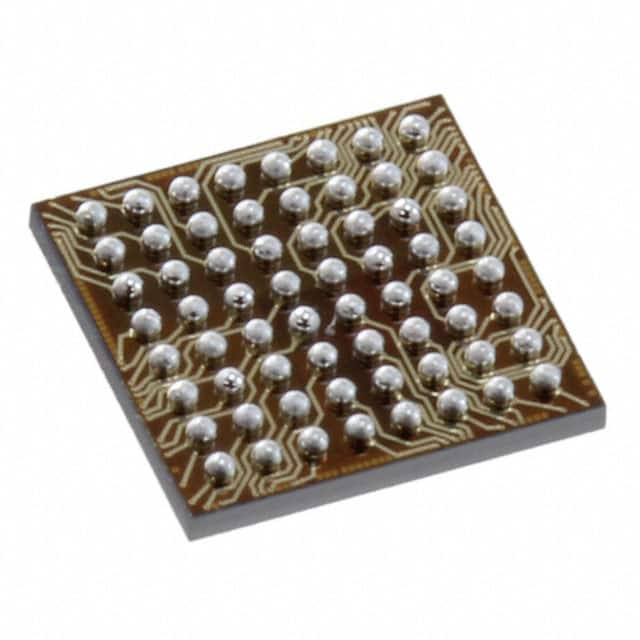Lihat spesifikasi untuk detail produk.

STM32F103RCY6TR
Product Overview
- Category: Microcontroller
- Use: Embedded systems, Internet of Things (IoT) devices, consumer electronics
- Characteristics: High-performance, low-power consumption, rich peripheral set
- Package: LQFP64
- Essence: ARM Cortex-M3 core microcontroller
- Packaging/Quantity: Tape and reel, 2500 pieces per reel
Specifications
- Core: ARM Cortex-M3
- Clock Speed: Up to 72 MHz
- Flash Memory: 256 KB
- RAM: 48 KB
- Operating Voltage: 2.0V - 3.6V
- Digital I/O Pins: 37
- Analog Input Pins: 10
- Communication Interfaces: UART, SPI, I2C, USB, CAN
- Timers: 3 x 16-bit, 1 x 32-bit
- ADC Resolution: 12-bit
- PWM Channels: Up to 15
- Operating Temperature Range: -40°C to +85°C
Detailed Pin Configuration
The STM32F103RCY6TR microcontroller has a total of 64 pins. Here is the detailed pin configuration:
- Pins 1-8: GPIO or alternate function pins
- Pins 9-16: GPIO or alternate function pins
- Pins 17-24: GPIO or alternate function pins
- Pins 25-32: GPIO or alternate function pins
- Pins 33-40: GPIO or alternate function pins
- Pins 41-48: GPIO or alternate function pins
- Pins 49-56: GPIO or alternate function pins
- Pins 57-64: GPIO or alternate function pins
Functional Features
- High-performance ARM Cortex-M3 core for efficient processing
- Rich peripheral set including UART, SPI, I2C, USB, and CAN interfaces
- Flexible clocking options with up to 72 MHz clock speed
- Ample flash memory and RAM for program storage and data handling
- Multiple timers and PWM channels for precise timing and control
- 12-bit ADC for accurate analog signal acquisition
- Low-power consumption for energy-efficient designs
Advantages and Disadvantages
Advantages: - Powerful ARM Cortex-M3 core for high-performance applications - Rich peripheral set for versatile connectivity options - Ample memory for storing programs and data - Low-power consumption for energy-efficient designs
Disadvantages: - Limited number of I/O pins compared to some other microcontrollers - Higher cost compared to entry-level microcontrollers
Working Principles
The STM32F103RCY6TR microcontroller is based on the ARM Cortex-M3 core architecture. It executes instructions stored in its flash memory and interacts with various peripherals to perform desired tasks. The microcontroller can be programmed using software development tools and libraries provided by STMicroelectronics. It operates at a specified clock speed and communicates with external devices through its communication interfaces.
Detailed Application Field Plans
The STM32F103RCY6TR microcontroller finds applications in various fields, including:
- Embedded Systems: Used in industrial automation, robotics, and control systems.
- Internet of Things (IoT) Devices: Enables connectivity and control in smart home devices, wearables, and environmental monitoring systems.
- Consumer Electronics: Powers consumer products such as home appliances, audio/video equipment, and gaming consoles.
- Automotive: Used in automotive electronics for engine control, dashboard displays, and infotainment systems.
- Medical Devices: Enables control and monitoring in medical equipment such as patient monitors and diagnostic devices.
Detailed and Complete Alternative Models
Some alternative models to the STM32F103RCY6TR microcontroller are:
- STM32F103C8T6: Similar features but with a different package (TSSOP20).
- STM32F103RBT6: Higher flash memory capacity (512 KB) and more I/O pins.
- STM32F103VET6: Increased RAM capacity (96 KB) and additional communication interfaces.
These alternative models provide options for different project requirements and can be considered based on specific needs.
Word count: 511 words
Sebutkan 10 pertanyaan dan jawaban umum terkait penerapan STM32F103RCY6TR dalam solusi teknis
Sure! Here are 10 common questions and answers related to the application of STM32F103RCY6TR in technical solutions:
Q: What is the STM32F103RCY6TR microcontroller? A: The STM32F103RCY6TR is a 32-bit ARM Cortex-M3 microcontroller from STMicroelectronics.
Q: What are the key features of the STM32F103RCY6TR? A: Some key features include a 72 MHz CPU, 64 KB Flash memory, 20 KB RAM, multiple communication interfaces, and various peripherals.
Q: What are some typical applications for the STM32F103RCY6TR? A: The STM32F103RCY6TR is commonly used in industrial automation, consumer electronics, motor control, and other embedded systems.
Q: How can I program the STM32F103RCY6TR microcontroller? A: You can program the microcontroller using various development tools such as STM32CubeIDE, Keil MDK, or Arduino IDE with appropriate libraries.
Q: Can I use the STM32F103RCY6TR for real-time applications? A: Yes, the STM32F103RCY6TR is suitable for real-time applications due to its fast CPU, interrupt handling capabilities, and real-time operating system support.
Q: What communication interfaces are available on the STM32F103RCY6TR? A: The microcontroller supports USART, SPI, I2C, CAN, USB, and other communication interfaces for connecting to external devices.
Q: How can I debug my code running on the STM32F103RCY6TR? A: You can use the built-in debugging features like Serial Wire Debug (SWD) or JTAG to debug your code using a debugger or an in-circuit emulator.
Q: Is the STM32F103RCY6TR suitable for low-power applications? A: Yes, the microcontroller offers various low-power modes and features like Sleep, Stop, and Standby modes to optimize power consumption.
Q: Can I expand the STM32F103RCY6TR's capabilities with additional hardware? A: Yes, the microcontroller has GPIO pins that can be used to interface with external sensors, actuators, displays, and other peripherals.
Q: Where can I find resources and support for the STM32F103RCY6TR? A: You can find documentation, datasheets, application notes, and community forums on STMicroelectronics' website, as well as online tutorials and examples from various sources.

